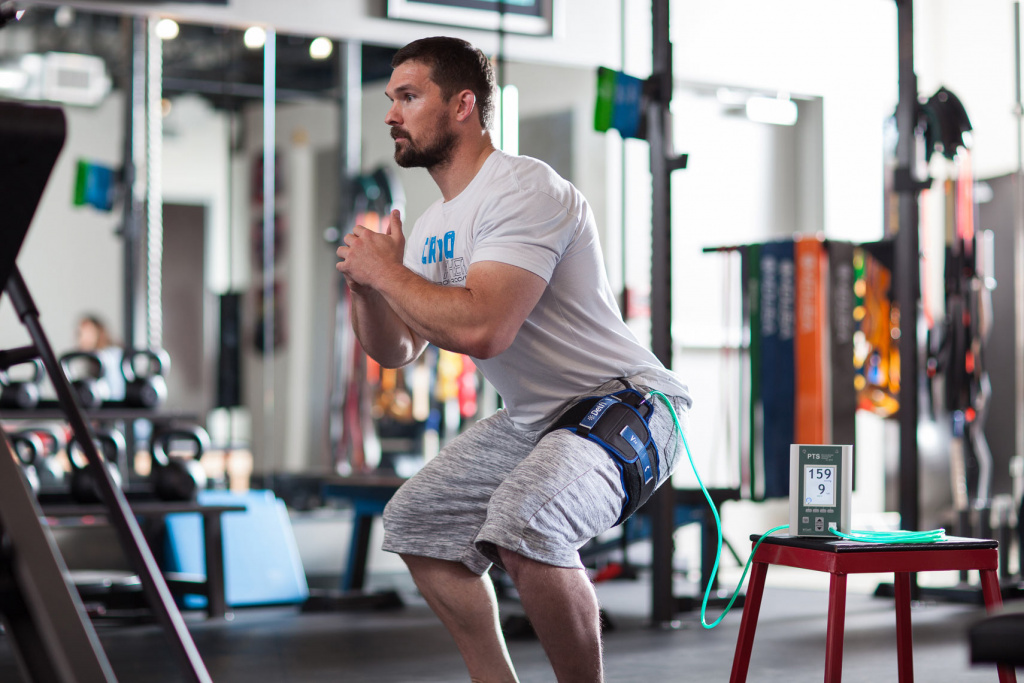Blood flow restriction (BFR) training is broadly defined as “a training method partially restricting arterial inflow and venous outflow in working musculature during exercise” (1). BFR training is originally credited to Dr. Yoshiaka Sato from Japan. Dr Sato received the inspiration for BFR (previously known as KAATSU training: meaning training with added pressure) after noticing swelling in his calves following a long time spent kneeling at a Buddhist memorial in 1966 (2). Dr Sato noted the swelling was similar to the sensation experienced after strenuous exercise, particularly calf-raises, and attributed this sensation to reduced blood flow. Since Dr Sato’s early work, the interest in BFR training has continued to grow in around the world.
Modern protocols of the training approach require a BFR cuff to be inflated either just below the shoulder joint or at the top of the thigh. This compresses the vasculature that would normally deliver blood flow to the muscle below the cuff. Compression partially restricts arterial blood flow, leading to an inadequate or restricted oxygen supply (hypoxia). However, BFR more consistently impedes venous outflow from the muscle. This increases the build-up of metabolites inside the muscle causing swelling (metabolic stress).

Modern scientific research has now determined that suitable BFR is a safe, feasible, and effective tool, when used appropriately (1). BFR is typically performed alongside low-intensity resistance training [20-40% of 1 repetition maximum (1-RM)]. This article will therefore highlight the benefits and risks associated with BFR resistance training and will do so focusing on the following:
1. Muscle strength gains following BFR resistance training
2. Muscle hypertrophy gains following BFR resistance training
3. The risks of BFR resistance training
Strength Gains Following BFR Resistance Training
BFR improves strength following low-intensity resistance training in a rapid time frame (<3 weeks) (1). It is proposed that the hypoxia-induced by BFR training actively recruits the fast-twitch type 2 muscle fibres over the slow-twitch type 1 muscle fibres because of the limited supply of oxygen (3). Fast-twitch type 2 muscle fibres generally produce more force and have a faster contraction time than type 1 slow-twitch muscle fibres (4).
However, an individual will always gain more strength with high-intensity resistance training. Strength is specific, meaning if you want to lift heavier weights you need to train with heavier weights. Restricting muscle oxygen delivery is not as effective at improving strength as placing a muscle under high mechanical tension (time the muscle spends producing high force contractions). Nevertheless, BFR does present a secondary option for individuals who do struggle to engage in high-intensity resistance training (e.g. older adults or individuals undergoing rehabilitation from injury/ illness), providing that safe protocols are strictly followed. These individuals may be able to achieve greater short-term strength gains if they use BFR as an appropriate tool alongside low-intensity resistance training.
Hypertrophy Gains Following BFR Resistance Training
Gains in muscle size (increased muscle fibre size) following low-intensity resistance training with BFR, are often confused with acute muscle swelling (edema). Reduced venous outflow from muscle does promote the build-up of metabolites (inorganic phosphate, lactic acid, positively charged hydrogen ions) and fluid inside the muscle (cell swelling), which many bodybuilders utilise during high repetition sets to get a ‘pump’. This muscle pump effect will certainly make a muscle ‘look bigger’ immediately following training, but this does not necessarily translate into an increase in muscle fibre size.
Nevertheless, chronic low-intensity resistance training with BFR (>3 weeks) does increase muscle fibre size. In fact, an individual can gain an equal amount of muscle size (hypertrophy) with lower intensity BFR training, as with higher intensity training (1). This is a very positive finding for individuals who want to gain muscle but are unwilling or unable to engage in high-intensity resistance training (e.g. lifting heavy weights). Low-intensity resistance training with BFR leads to muscle hypertrophy in the following ways:
• Hypoxia and metabolite build up inside the muscle, increasing the recruitment of type 2 muscle fibres [type 2 fibres are generally larger and more responsive to growth compared to type 1 fibres (4)]
• Cell swelling (metabolite and fluid build-up) causes a muscle cell to send out signals which promote growth (3,5) (due to increased pressure, causing the cell to perceive a threat to its own integrity)
• Lower muscle damage and soreness permits a higher training frequency (1-2 times per day), compared with high-intensity resistance training (1-2 times per week) (1)
Most research has been performed in the elbow flexors (biceps) and knee extensors (quadriceps) because these are the easiest muscles to target with in controlled research settings. However, it is highly likely that other muscles (e.g. triceps, hamstrings, calves) will respond in the same way.
The Risks of BFR Resistance Training
Despite such benefits, inappropriate use of BFR training can cause serious health issues. Unsurprisingly, most of the risks are linked with the effects that BFR training has on the cardiovascular system.
Blood vessel obstructions (thromboembolism) are commonly reported in individuals who use BFR training inappropriately, especially with the blood vessels in the lower limbs (1). This can lead to increased heart rate, elevated blood pressure, and hypotensive syncope (temporary loss of consciousness due to insufficient oxygen delivery to the brain) (1). Therefore, individuals who are suffering from hypertension, cardiovascular disease, or are at increased risk of blood clots [pregnant women, cancer (treatment), recent hospitalisation/ surgery, family history of blood clots, etc], should exercise extreme caution when using BFR and should probably avoid it altogether. They should certainly speak with a primary care clinician (e.g. G.P.) before trying any BFR training.
Numbness (blocked nerve transmission) is also commonly reported among those who use BFR training inappropriately, again, especially in the lower limbs (1). Numbness can be caused by vascular obstruction/ compression, excessive muscle swelling, and BFR cuffs directly compressing nerves. In fact, the original inventor of BFR, Dr Sato, was hospitalised on multiple occasions in 1967 with lower body numbness, shortness of breath, and eventually a pulmonary embolism (a blockage in one of the lungs arteries). As he reflects in a 2005 publication (2):
“Up to that point I had ignored the numbness in my legs during KAATSU Training and continued with my training despite the discomfort. At one point, however I began experiencing an acute attack of shortness of breath. I went to the emergency room and was diagnosed with a pulmonary embolism. Once the physician who was treating me learned of my training methods, he warned me to immediately discontinue my KAATSU training”
Thankfully Dr. Sato moderated his use of BFR, and started researching how to safely use the technique. Modern science has continued this research and arrived at some practical recommendations of how to use BFR training safely, and effectively. These practical recommendations will be discussed in part 2 of this blog coming soon. Stay tuned!
Disclaimer: This article is not intended as an endorsement of blood flow restriction training. Instead, this article is an evidence-based discussion about the benefits and risks of this novel training tool. If an individual is considering using blood flow restriction training as part of their training program, this should be done with the approval of the individual’s healthcare provider, and under the supervision of a suitably qualified and experienced health and fitness professional.
References
1. Patterson, S.D., Hughes, L., Warmington, S., Burr, J., Scott, B.R., Owens, J., Abe, T., Nielsen, J.L., Libardi, C.A., Laurentino, G. and Neto, G.R., 2019. Blood flow restriction exercise: considerations of methodology, application, and safety. Frontiers in physiology, 10, p.533.
2. Sato, Y., 2005. The history and future of KAATSU training. International Journal of KAATSU Training Research, 1(1), pp.1-5.
3. Pearson, S.J. and Hussain, S.R., 2015. A review on the mechanisms of blood-flow restriction resistance training-induced muscle hypertrophy. Sports medicine, 45(2), pp.187-200.
4. MacDougall, J.D., Sale, D.G., Elder, G.C.B. and Sutton, J.R., 1982. Muscle ultrastructural characteristics of elite powerlifters and bodybuilders. European journal of applied physiology and occupational physiology, 48(1), pp.117-126.
5. Schoenfeld, B., 2020. Science and development of muscle hypertrophy. Human Kinetics.


